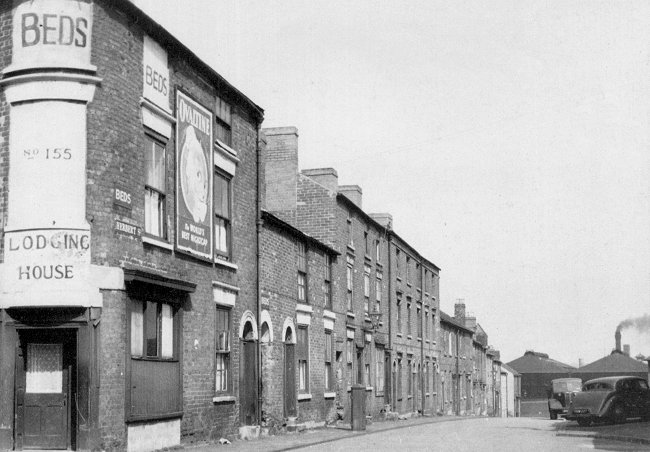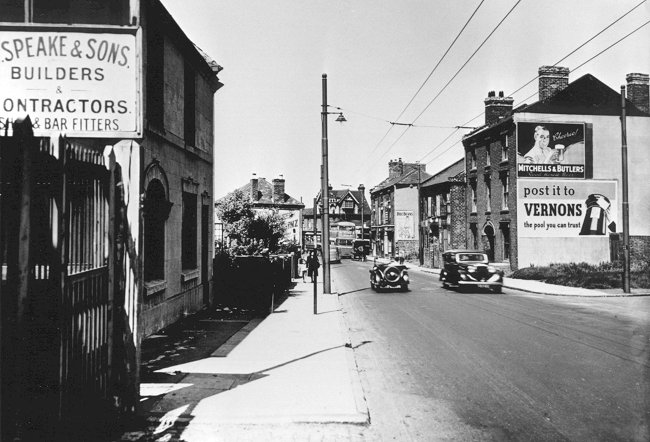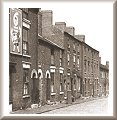|
A reader who wishes to remain
anonymous has sent in an evocative account of life in
one of the working-class heartlands of old Wolverhampton
- Herbert Street. It is a memoir that will resonate with
anyone who grew up in the older neighbourhoods of
Dudley, Walsall, West Bromwich, Birmingham and elsewhere
in the West Midlands.
I was born in 1920, in Herbert
Street, Wolverhampton. It was surely one of the busiest
streets in the town. It was cobbled, but has recently
been tarmacked to give the coaches from the Faulkland
Street coach park a smoother ride. In its heyday,
thousands of carts and lorries trundled down the street
- carts with solid rubber tyres to be weighed in at the
bottom before entering the Herbert Street goods station.
The street always had a line of
carts from early morning till late evening. The houses
were just slums really, and in the 1920s the one side of
Herbert Street was flattened, along with Faulkland
Street, Littles Lane and Southampton Street. Southampton
Street ran along the bottom of Herbert Street, Falkland
Street, Littles Lane and Montrose Street and only had
houses on one side. The railway wall was on the other.
So with only one side of Herbert Street remaining, this
was just an area of wasteland, dotted with old wells,
cellars and broken bricks. The only part of the side of
Herbert Street to be knocked down before the war was No
5 court - four bad slums at the front and four even
worse slums at the back.
|
|

Herbert Street. |
|
Families
People had to share four toilets
between eight dwellings. Each of these consisted of a
board with an aperture in it with a half dustbin
underneath (no flush toilet) which was dragged down the
entry each week by the "night dirt" men and tipped into
a special cart - happy days! There was a pump in the
small square of these eight slums before they modernised
it. By the side of the pump they put a tap (no more
pumping), one tap between eight families. Great!
The older generation, my grandad
and gran, with whom my mother and father and Albert, my
cousin, and I lived, had the hobby of keeping pigeons,
along with lots of other old folk, and these were raced
over a distance of three quarters of a mile. This was
from a place called the Garden Hills, which overlooked
the engine repair yard of the GWR on the Stafford Road,
and thence to the various yards of the pigeon fanciers.
It was a time trial race and they
had to move from yard to yard as the pigeons were
released at specific times. It was all done with
precision, but that didn't stop a lot of arguments as a
pigeon had to "touch down" to be timed correctly. I can
see my cousin Albert on the wooden steps with the hen of
the cock who was flying, trying to entice it to land
quietly. The race was only 3d or 6d to enter, but crowds
went from yard to yard on a Saturday morning and there
were those who tried to scare the pigeon into not
landing first time, so you can imagine how sometimes
there were ugly scenes.
As I've said, Southampton Street
ran along the bottom of four streets and there are only
about 50 or 60 yards left now. Nevertheless this is the
site of the old Wulfrun coal wharf and the point, until
it was filled in, where the canal boats entered the
Herbert Street goods station. The only indication of it
is a walled-up bridge still visible today. As you pass
over the bridge towards Littles Lane bridge there is the
lock keeper's house, at the side of which is a little
chapel and school house, now used as a welding shop, and
so on down to the "Nineteen Steps" and Butlers Brewery, with a gate one person at
a time could get through. The chapel was exclusively for
the boat people.
The wasteland of the three streets
was put to good use between 1930 and 1935, when you
could earn 2/- for a load of broken bricks (you had to
break them to the size of a tennis ball and they were
used as foundations for new roads). There were dozens of
piles of broken bricks with men and children hard at it
for a bit of pocket money. Between the canal bridges
I've mentioned was a public house (I believe it was
called the Talbot), used mostly by the boat people.
After 1930, when the public house closed down, a lady
made sweets there. It was eventually demolished.
|
|

Another view of Herbert Street. |
|
The young chaps of the 1930s
couldn't get jobs and they would play with "glarnies" at
"shoot the ring" for cigarettes or ha'pennies. They were
experts at this and could sometimes shatter the glass
marble with the force they could shoot. With a large
number of wells, it was inevitable that somebody was
going to fall down one of them. The boy in question had
been down for some time when the milkman, who sold milk
from a churn suspended between two wheels, arrived to
effect a last minute rescue. The lad was in a bad way
when rescued by this courageous man who went down the
well. The rescuer finished up covered in mud and slime,
and as he came into the street to retrieve his milk
float, Mr B, who lived next to us, told him to go up the
entry to his brew house and get cleaned up. What he
forgot to tell him was that his daughter, who was 20,
was having a bath in the washing tub and she gave one
scream when he opened the door. You could hear it all
over the place. He said it was worse than going down the
well. She was a really lovely girl who got married, had
a baby and a few days later died aged 24. It was really
tragic.
There was one large well in the
middle of what is now the coach park. It had two
semi-circular plates and was 5ft to 6ft in diameter,
with two semicircular holes in the middle to take the
pump. It was very deep, but it had no water. We know
because we used to drop bricks down it and it took a
second or two till we heard it hit the bottom.
In about 1935 an organisation
called the Good Companions levelled the patch off. They
were unemployed and their wages were a 1/- a day and a
hot dinner. I can't remember the empty well ever being
filled in, and after being levelled off by the Good
Companions the two plates were still visible, even up to
the start of the war.
Survived
Was it ever filled in? And was
there ever a windmill there? A few yards away there were
three or four stone wheels about 3ft 6in in diameter and
about 18in deep. Were they buried when the patch was
levelled? The lads who had no chance of a job decided to
join the Army and, Albert included, spent five years in
India. At the start of the Second World War they were
first to be called up, but most survived Dunkirk and the
war.
The only part of Littles Lane
remaining is about 25 yards long, but the original
buildings are still there along with a plaque on the
wall commemorating the men of South Staffs who gave
their lives in the Great War: Moogan, Nolan, Pitt,
Connoly etc. There were 13 or 14 altogether and to cap
it off they've changed the name of this small stretch of
Littles Lane to Thornley Street, just off Stafford
Street.
On Sundays we had the Sally Army to
entertain us and sometimes the Boys Brigade or Scouts,
along with the watercress man shouting his wares, the
hurdy-gurdy man and ice cream vendor. Most of the time
on Sundays we went for long walks to the Ball at Coven
or over the seven cornfields to Baggeridge Wood or
bluebelling at Orton Hills, "scrumping" as we went along
or blackberry picking, returning late at night. |
|

Stafford Street. |
|
The canal in the summer was our
swimming pool and we were always in when the weather was
hot. Nobody had 2d for Wolverhampton Baths. The Co-op,
in 1931 or thereabouts, started a scheme for a trip to
Rhyl. You got a card on which you saved 2/- in blue 2d
stamps (12 stamps); for this you had a bag of buns and a
small bottle of milk on the train, and during the
afternoon at Rhyl another bag of buns and bottle of milk
with a packet of biscuits on the road back. It took
months to save this 2/- and we never had any money to
spend when we got to Rhyl, so to get presents to take
back home there was a lot of "pinching". I shall never
forget how me and my pal went into Woolworths and he took
a fancy to a ball on a strip of elastic, so into his
carrier bag it went and we moved away. Imagine our
horror when the ball suddenly shot out of the bag back
on to the counter, it happened to be tied to about 100
others. Sadly my friend was killed on the Anzio
beach head.
I'd like to tell you about two
attractions or entertainments. One was an escapologist
who was put into a straight jacket and then tied up with
a 30ft or 40ft length of chain. This was on the site of
the Tin Shop Yard, less than a stone's throw from the
Wolves football ground, and took place on a Saturday
afternoon before the match. He always had a big
audience. A chap who lived in Herbert Street invariably
had the job of tying him up. He was well over 6ft and
built like a heavyweight boxer. He was about two to
three years older than us, but at 14 years of age he
could carry one of us under each arm and he certainly
made a good job of putting the chain round his neck and
putting his knee in his back to make sure it was tight.
I don't think he realised his own strength, for the
bloke was fighting to get his breath, his face was the
colour of beetroot. After being trussed up he'd drop on
the ground of the Tin Shop Yard, which was littered with
broken bricks and bricks half-buried, and proceed to get
free.
Sometimes it took a fair amount of
rolling and shaking to try to get the chains loose, he
must have been black and blue with bruises, and then
there was the straight jacket problem. He certainly
earned the coppers he got from the crowd. I've seen
escapologists on the TV and on the stage but he was the
real McCoy.
The other entertainment was a
Professor Povey, who climbed a mast about 50ft high
where he was set alight by an assistant and dived into a
tank 15ft to 20ft in diameter, which was also set alight
by an onlooker. We were about 12 at the time and the
tank was about 6ft deep, and of course we got as near
the tank as possible. It was a free show with just a
collection after the dive.
Cold
Down he came in flames. It wasn't a
dive as such but a sort of belly-flop. He doused the flames all right and
splashed half the tank of water over us. We were
saturated, but we had to laugh although it was a cold
dark night on the site of today's Wolverhampton Market.
At the bottom of the Nineteen Steps was a fish and chip
shop which a Japanese man ran. This was well before the
war. I don't know what happened to him. His name was Mr. Watibiki and he was probably interned. I do know he had
relations who are still alive today.
The people down Herbert Street
could tell some tales - everyone was a character. Relations of Terry Duffy, who ran
the engineering union, and the McDermots lived there.
Charlie Stowe, the Walker Cup golfer, married a girl
from that street. |
 |
Return to
the
previous page |
|